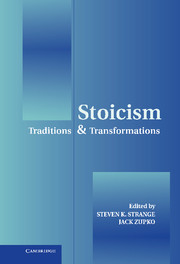Book contents
- Frontmatter
- Contents
- List of Contributors
- Acknowledgments
- List of Abbreviations
- Stoicism
- Introduction
- 1 The Socratic Imprint on Epictetus' Philosophy
- 2 The Stoics on the Voluntariness of the Passions
- 3 Stoicism in the Apostle Paul: A Philosophical Reading
- 4 Moral Judgment in Seneca
- 5 Stoic First Movements in Christianity
- 6 Where Were the Stoics in the Late Middle Ages?
- 7 Abelard's Stoicism and Its Consequences
- 8 Constancy and Coherence
- 9 On the Happy Life: Descartes vis-à-vis Seneca
- 10 Psychotherapy and Moral Perfection: Spinoza and the Stoics on the Prospect of Happiness
- 11 Duties of Justice, Duties of Material Aid: Cicero's Problematic Legacy
- 12 Stoic Emotion
- Works Cited
- Name Index
- Subject Index
6 - Where Were the Stoics in the Late Middle Ages?
Published online by Cambridge University Press: 11 July 2009
- Frontmatter
- Contents
- List of Contributors
- Acknowledgments
- List of Abbreviations
- Stoicism
- Introduction
- 1 The Socratic Imprint on Epictetus' Philosophy
- 2 The Stoics on the Voluntariness of the Passions
- 3 Stoicism in the Apostle Paul: A Philosophical Reading
- 4 Moral Judgment in Seneca
- 5 Stoic First Movements in Christianity
- 6 Where Were the Stoics in the Late Middle Ages?
- 7 Abelard's Stoicism and Its Consequences
- 8 Constancy and Coherence
- 9 On the Happy Life: Descartes vis-à-vis Seneca
- 10 Psychotherapy and Moral Perfection: Spinoza and the Stoics on the Prospect of Happiness
- 11 Duties of Justice, Duties of Material Aid: Cicero's Problematic Legacy
- 12 Stoic Emotion
- Works Cited
- Name Index
- Subject Index
Summary
Where were the Stoics in the late Middle Ages? The short answer is: everywhere and nowhere.
Stoicism is not a sport for gentlemen; it requires far too much rigorous intellectual work. Most of Western history consists of gentlemen's centuries. But there were the couple of centuries, the fourth and the third b.c., in which the ancient philosophical schools were created, and there were the three centuries from a.d. 1100 to 1400, when medieval scholasticism flourished – centuries that produced a considerable number of tough men ready to chew their way through all the tedious logical stuff that disgusts a gentleman and to make all the nice distinctions that a gentleman can never understand but only ridicule, distinctions necessary to work out a coherent, and perhaps even consistent, picture of the structure of the world. In this respect, a good scholastic and a good Stoic are kindred spirits. As an attitude to doing philosophy, Stoicism is everywhere in the late Middle Ages.
Also, bits and snippets of Stoic doctrine were available in a large number of ancient writings and could inspire or be integrated in scholastic theory. Further, some works with a high concentration of Stoicism were widely known, notably Cicero's Paradoxes of the Stoics, De Officiis, and Seneca's Letters to Lucilius. Finally, Saint Paul was a crypto-Stoic ethicist, and so were several of the church fathers.
- Type
- Chapter
- Information
- StoicismTraditions and Transformations, pp. 108 - 131Publisher: Cambridge University PressPrint publication year: 2004
- 6
- Cited by



